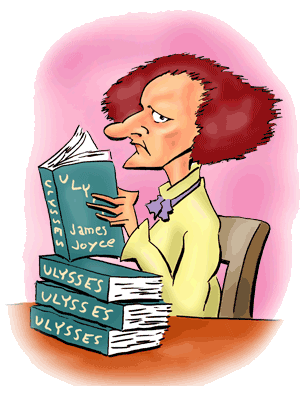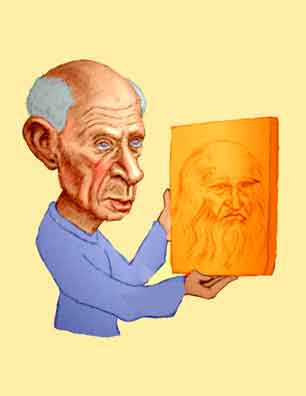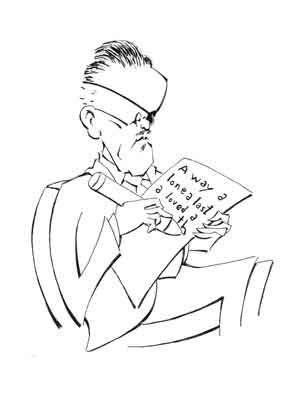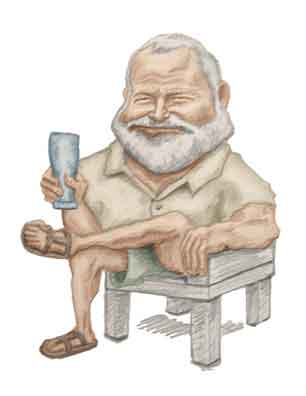Sylvia Beach
Publisher, Author, and
All-Around Nice Lady

Sylvia Beach
The Lady Publisher
Sylvia Beach's parents did not have a particularly happy marriage. At first glance that might seem unusual since her dad, Sylvester, was a high-powered Presbyterian minister in Princeton, New Jersey. Her mom, the former Eleanor Orbison, also came from a religious family and was the daughter of a medical missionary. Eleanor had in fact been born in India.
Eleanor met her husband when he was teaching Latin at her high school. They married in 1882 (Eleanor was eighteen), and Sylvia was born in 1887 in Baltimore, the last of five kids. Christened as Nancy, Sylvia adopted her preferred name as a teenager.
With Sylvester's credentials (he had a Doctor of Divinity from Princeton), he could count on appointments to large and important congregations. And sure enough, in 1902 Sylvester moved his family to Paris where he took charge of the American Church in Paris. He served there for a few years and then returned to America where he was hired as the minister of the Princeton Presbyterian Church.
Among the congregation was the President of Princeton, a gentleman who later became Governor of New Jersey and then later President of the United States. Obviously we mean Woodrow Wilson, and Sylvia said Woodrow always considered Sylvester to be the family pastor. When Woodrow's two daughters were married at the White House, Sylvester officiated, as he did in 1924 at Woodrow's funeral.
The exact nature of her parents' troubles isn't known. But some writers have suggested the Good Reverend may have been tending to the needs of the ladies of the congregation - but less as taught in the Holy Writ than in a manner made famous by some well-known television evangelists. That reminds us of the joke about when a new divinity student was asked why he wanted to enter the ministry, he replied, "To make a lot of money, drive fancy cars, and meet a lot of girls."
Eleanor may have not known anything specifically about her husband's spiritual ministrations (as we don't) but suspicions do not a contented marriage make. In any case, she decided that unofficial albeit temporary separation was the best way to minimize an uncomfortable situation. This resulted in a number of trips to Europe with just Eleanor and the kids and in 1916, Sylvia went to Spain on her own. The next year she went to Paris.
The year 1917 would seem to be a most inconvenient time to strike off on your own in Europe. There was, of course, a war on. However, in 1917, the Yanks were over there, and Paris was more or less a safe place for an independent 30-year-old woman. To help the war effort, Sylvia worked as an agricultural laborer and also served with the Red Cross in Serbia. Among other things, she noticed how the Red Cross seemed to reserve the highest ranks for the men, an observation which Sylvia said turned her into a feminist.
Although her mom had a high school education and her dad a doctorate from Princeton, Sylvia's formal education had been virtually nil. She only attended school for a few months and that was when she was in France with her folks. But she was well read and ultimately decided to open a bookstore. Her dad and mom had said they would put up the capital, although they were surprised when it was clear that Sylvia did not intend to return to New Jersey. Sylvia had decided not even to return to America, but decided to open her store in Europe.
At first the plan was to go to London and specialize in French language books. After all, France was just across the Channel and she could easily take trips to Paris to replenish her stock. But she needed some advice on how to go about the start-up.
In Paris Sylvia had been reading a book and found inserted in the pages a note advertising a bookstore. The ad mentioned a book she wanted to read, Vert et Prose by Paul Fort. After some looking she found the store in the Rue d'Oleon.
Sylvia was originally hesitant to go in since when she looked in the window there didn't seem to be any customers. But the owner - a rather full figured lady wearing a simple "peasant" dress - came to the door and asked her in. Somewhat to Sylvia's surprise, the proprietor of the shop - whose name was Adrienne Monnier - was quite friendly and showed no aloofness that Americans expect from the Gallic populace. Actually, Adrienne was quite an Anglophile, and as Sylvia loved France and Paris, the two ladies soon became quite chummy.
Adrienne's bookstore, which she was to soon call La Maison des Amis des Livres (The House of the Friends of Books), was not just a bookstore but also a lending library. That is, you could pay a yearly fee and then check out books. Sylvia signed up.
Sylvia still intended to open a bookstore in London. Unfortunately, she received discouraging advice from other booksellers. There really wasn't a demand for French books there, and rental space in London was expensive.
The alternative was to open an English language bookstore in Paris. So with Adrienne's help, Sylvia started looking around, and just a block or so from Adrienne's shop (that is if you think of Paris having blocks), they found an empty store for rent on the Rue Dupuytren.
Although it took a lot of work (even Sylvia's sister Holly helped out) and a generous check from her mother (it's surprising how much cash Princeton ministers had on hand), Shakespeare and Company opened on November 17, 1919. Sylvia soon found an unexpected bonus in that she already had a customer base. Many of Adrienne's customers either knew English or wanted to learn it, and so came to Sylvia's store as both friends and customers. Shakespeare and Company, like La Maison, was also a lending library and Sylvia gave 20 % discount to students, teachers, and members of Adrienne's library. All in all she got off to a good start.
Even better, some well known writers began to show up, even the famous André Gide. Business became so brisk that she wrote her mom to send her some more books and money to purchase future stock.
Of course, some of the customers were Americans, and they started showing up with increasing frequency. Then in 1920, she had a visit from Gertrude Stein. At the time Gertrude hadn't published a lot but she and her brother Leon were well-known as a patrons of modern artists. Gertrude liked the works of Picasso although Leon thought Pablo's smatterings were rubbish.

Pablo Picasso
Leon though his smatterings were rubbish.
In 1921, a store across the street from Adrienne's shop became available. Sylvia moved Shakespeare and Company to the Rue d'Oleon and the two stores became for all practical purposes a single enterprise with different departments. By then Adrienne and Sylvia were sharing an apartment and had become partners in the most complete sense.
The Rue d'Oleon is a fairly small street not far from the lengthy and spacious Boulevard Saint-Germain and so was on the Left Bank of the Seine (the Left Bank/Right Bank orientation is based on your facing with the flow of the river). Sylvia and Adrienne's shops were in a good location and more or less in the center of the city. It was on the same side of the Seine as the Eiffel Tower and a couple of miles east. It was only a short walk from the Luxembourg Palace (where the French Senate met) with the surrounding spacious gardens.
More and more Americans were showing up and that made sense. After the war, there was a good chunk of the American (and British) war veterans remaining in Paris, and they supplemented the Left Bank crowd. The group has been famously dubbed by Gertrude Stein as Une Génération Perdue - that is, "A Lost Generation" - which drums up the image of - as one writer once put it - a "tight band of pot-smoking nihilists wandering around looking for Mommy to lead them out of the dada wilderness". This was not what they were and none of the Lost Generation thought of themselves as such. They were actually nothing more (or nothing less) than a number of English-speaking young people that after the war decided to spend time in Europe pursuing their interests and careers which were often artistic and literary. They were, as one member of the Lost Generation said, a pretty solid group.
The Lost Generation is usually associated with writers, mostly American although there were British and Irish among them. Among the important (although not well-remembered) members were Ernest Walsh (an Irish poet), Ford Maddox Ford (a pseudonym of an editor and writer), and Hart Crane (an American poet). Among those remembered a bit more are Ezra Pound and the lady we mentioned earlier, Gertrude Stein. Gertrude's books were not major sellers even after the 1930's when she found mainstream publishers. One of her publishers said he rarely needed to run more than a single edition of 500 copies which would sell out and not require a second printing. More familiar names are Scott Fitzgerald (known to many middle and high school students for The Great Gatsby), T. S. Elliot (The Waste Land), and the long-lived poet and Librarian of Congress, Archibald MacLeish.
You sometimes look at the publishing history of the early writers and you wonder how they managed to get by. It was some years before many of them published any books and the magazines they wrote for had limited circulation.
At least part of the answer is that the early 20th century was the last era of the great literary patrons. That is, you had rich people with a literary bent that would put up a chunk of their inherited family wealth to keep a magazine running or would put up printing and circulations costs to bring out a book. That way the authors could get paid even if what they wrote didn't sell. And often the patrons would just give the writers and artists handouts or - as did wealthy American lawyer John Quinn - purchase their original manuscripts for a decent fee.

James Joyce
He hung out.
Not all patrons were rich, though. Sylvia with the resources of Shakespeare and Company would advance loans to cash-strapped authors as well serve as a mail drop for their correspondence. Although she did so with cheerfulness, privately Sylvia sometimes felt put-on by authors who were not always quick at repaying their loans.
Sylvia herself would also put up costs and arrange printing of some of the fledgling author's books. Without doubt the most important of Sylvia's publications - under the Shakespeare and Company imprimatur - was what some critics call the most important book in the 20th century. That book is, of course, Ulysses by James Joyce, and we know it's important since even though few people buy the book today and even fewer read it, college professors tells us so.
Jim was Irish and his works dealt with the life and times of the Dublin of his youth. But for virtually all his adult life he had lived on the Continent, mostly in Trieste where he achieved some literary fame with the publication of his novel, A Portrait of the Artist as a Young Man. Although not a great seller, the book received considerable praise from famous writers of the time, and it established Jim as a serious author.
Ulysses was originally published in the literary magazine, The Little Review. However, you'll find some of the scenes and narratives are a bit racy (if you can get that far) and when the magazine was imported into the United States copies were seized and destroyed. So it wasn't likely that any American publisher would pick up the book.
So Sylvia stepped in and agreed to print the chapters as a book. She found a printer who agreed to run off 1000 paperback copies. The cost was so much that Shakespeare and Company - and so Sylvia - became financially strapped.
The book was banned in the United States, and sales of Sylvia's edition were not particularly high even though American tourists liked to buy the book and - quote - "smuggle" - unquote - it into the country. But the customs inspectors, even if they bothered opening the luggage, generally just let the book in. Most editions in America were printed as pirated copies for which neither Jim nor Sylvia received a dime.
But in 1933, Bennett Cerf, president of Random House Publishers (and later famous as a panelist on the old What's My Line television show), decided to bring out an official and authorized US edition. He did this by smuggling a copy in but making sure it got seized by customs. The resulting court case went before a friendly judge who ruled the book was not obscene. Jim got a 15% royalty which for the first US edition would have landed him over $5000. Pretty good dough in 1934.
And Sylvia? Although she was the original publisher, she got nothing. Some people think was a bit of a chintz on Jim and Bennett's part as she had put up the money to first get the book out. We don't know what royalty she paid Jim - probably not much - but at the same time it seems Bennett should have at least bought the remainder of the copies of her first edition, which we should point out, now bring six figures for a single paperback volume.
But without doubt the most famous of the American expatriates to frequent Sylvia's bookstore was Ernest Miller Hemingway, who wrote about his days in Paris in the posthumously published book with the misspelled title, A Moveable Feast. Now one of Ernest's favorite pastimes was writing books that trashed his friends (and soon to be former friends) by putting them in as thinly disguised fictional characters. Ernest's portrayal of the character Richard Gordon in To Have and Have Not was so obviously based on American writer John Dos Passos that Ernest's editors warned him it was libelous and they had to stick the formulaic "This book is a work of fiction. Names, characters, and incidents are products of the author's imagination or are used fictitiously. Any resemblance to actual events or locales or persons, living or dead, is entirely coincidental." This serendipity evidently worked although we do know that Ernest and Dos's friendship eventually evaporated.

Ernest Hemingway
He was nice to Sylvia.
Ernest's friendship with writer F. Scott Fitzgerald also had collapsed mainly because Ernest made a mention of Scott's emotional and physical breakdown in the short story, "The Snows of Kilimanjaro". Scott read the story and sent a curt note to Ernest to lay off him in print. It was a fine story, Scott wrote, one of Ernest's best, but the "poor Scott Fitzgerald" reference cost him a night's sleep. Ernest replied rather snottily that he would write any thing he wanted.
(Actually if you look in reprints of the story, Scott isn't mentioned and the name has been changed to "Julian". Scott, we hear, had also complained to Max Perkins who agreed to change the name.)
Although Ernest did later tell friends how Scott helped promote his career, in A Moveable Feast Ernest paints Scott as a childish, petulant, hypochondriacal, and naive alcoholic. Although A Moveable Feast has been used as source material by some biographers, others have looked at contemporary letters of both Scott and Ernest and doubt the specified incidents actually occurred. As far as veracity of the book itself, Ernest did write in the preface, "If the reader prefers, this book may be regarded as fiction." Actually that's good advice to follow.
But the picture Ernest paints of Sylvia is unfailingly polite. A comment on her fine features (and pretty legs) notwithstanding, he says that no one was kinder to him. And indeed Sylvia had printed the first collection of Ernest's work, Three Stories and Ten Poems which we must admit is not Ernest at his finest. In fact when Ernest's parent got copies of the book, they were so aghast at the ending of "Up in Michigan" that they threw the books out. Ernest, by the way, was a pretty rotten poet.
With the solidification of Fascism as the government of Germany in 1933, many of the Lost Generation returned to their own countries. Sylvia, though, remained in Paris and when Germany invaded France in 1940, she had a visit from a German officer demanding a copy of James Joyce's last - and to the Nazi's "degenerate" - book Finnegan's Wake. Refusing to sell him anything, Sylvia closed the shop and hid the books off-premises.
The deal France struck with Germany was that the southern part of the country would remain independent but the west coast and the north - which included Paris - would be occupied and governed by Germany. So after December 11, 1941, when Germany declared war on the United States, Sylvia was an enemy alien and was imprisoned in an internment camp. She was released, though, after about six months and returned to Paris where she was allowed to live undisturbed.
In 1944, Paris was liberated, and the first American to stop by Shakespeare and Company was Ernest Hemingway, now a war correspondent for Colliers magazine. Adrienne and Sylvia were overjoyed to see their friend, but Sylvia never reopened the bookstore. Nor did she return to America, although after she died in 1962, she was buried next to her father in Princeton. When and where her mother died and where she is buried seems to be an unsolved mystery.
References
Shakespeare and Company, Sylvia Beach, Faber, London, 1958.
Sylvia Beach and the Lost Generation, Noel Riley Fitch, Norton, 1985.
Women of the Left Bank, Shari Benstock, University of Texas Press, 1986.
A Moveable Feast, Ernest Hemingway, Schribners, 1964.